As the longest waterway in British Columbia, the Fraser River has historically also been its most significant. It has served as both an important source of sustenance and actual gold. And while the gold rush has long since subsided, fishing on the Fraser River is as epic as it’s ever been, holding a promise of battles with some of the finest freshwater game out there.

In this article, we’ll try and present this world-class fishery in its full glory. First, you’ll get to read about the amazing fish swimming through its waters. Then, we’ll cover some ways to approach the Fraser River. After that, we’ll delve into some areas to fish, as well as regulations to look out for. Are you ready to find out more? Then scroll on!
What can I catch fishing on the Fraser River?
| Species | Jan | Feb | Mar | Apr | May | Jun | Jul | Aug | Sep | Oct | Nov | Dec |
|---|---|---|---|---|---|---|---|---|---|---|---|---|
| Sturgeon | Good | Good | Good | Great | Great | Great | Great | Great | Great | Great | Good | Good |
| Chinook Salmon | Weak | Weak | Weak | Weak | Weak | Good | Great | Great | Great | Good | Weak | Weak |
| Coho Salmon | Weak | Weak | Weak | Weak | Weak | Weak | Weak | Weak | Good | Great | Great | Good |
| Sockeye Salmon | Weak | Weak | Weak | Weak | Weak | Good | Good | Great | Great | Weak | Weak | Weak |
| Chum Salmon | Weak | Weak | Weak | Weak | Weak | Weak | Weak | Weak | Good | Great | Great | Good |
| Pink Salmon | Weak | Weak | Weak | Weak | Weak | Weak | Weak | Good | Great | Great | Good | Weak |
| Trout | Great | Great | Great | Good | Good | Good | Weak | Weak | Weak | Good | Good | Great |
| Char | Great | Great | Great | Good | Good | Good | Weak | Weak | Weak | Good | Good | Great |
Throughout the Fraser River’s waters, you’ll get the chance to wrestle one of the largest freshwater fish on the planet and some of the best pound-for-pound fighters. The action goes on year-round, though winter is best suited for hardy anglers who don’t mind the cold. So let’s dive into the species you can target fishing on the Fraser River.
White Sturgeon
There’s no fish more appropriate to begin the list with than the Fraser River’s staple species – White Sturgeon. These ancient river beasts have been roaming these waters for 200 million years according to scientists. That puts them in the company of creatures you’d see on Jurrasic Park!

And to further make the case that White Sturgeon are, in fact, dinosaurs, they’re among the biggest freshwater fish on the planet. They can reach lengths of over 3 meters (10 feet), weighing well over 500 pounds. And while Sturgeon that big are considered truly rare, a 3.5-meter specimen was caught in the Fraser River as recently as 2021.
What’s even wilder, however, is that Sturgeon have the power to match their size. Even though they weigh several hundred pounds, they still have the muscle to leap out of the water. Can you imagine what it’s like to hold on to a rod while a monster like that is thrashing about?!
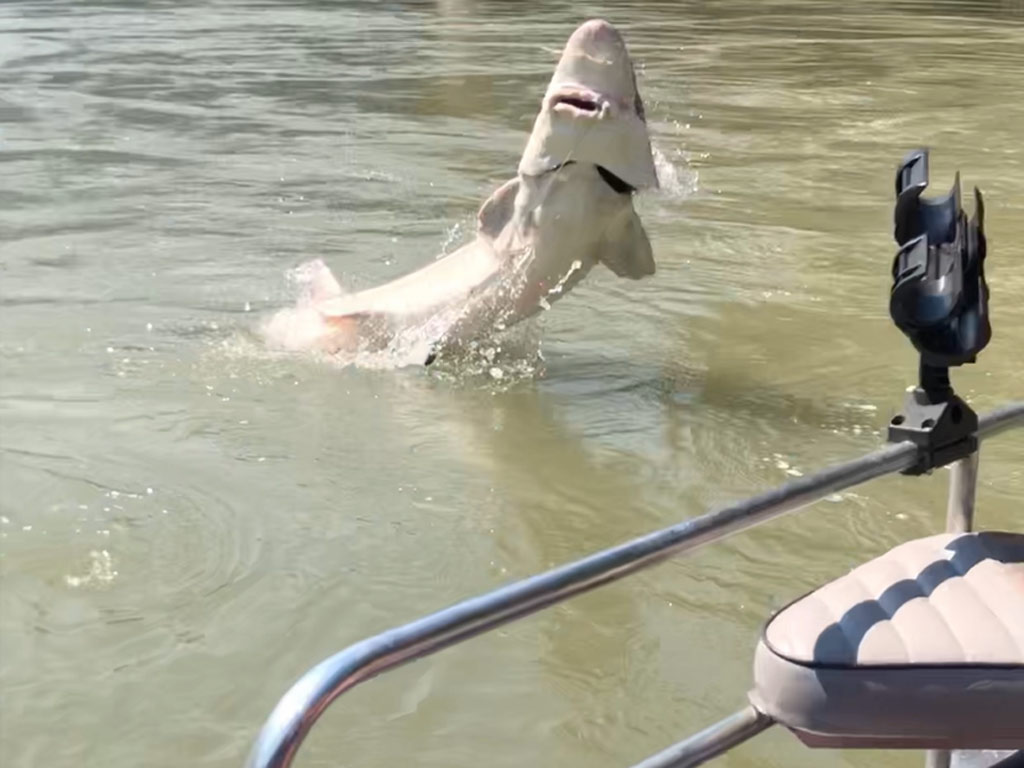
But before all that, you’ll have to find where the Sturgeon are hiding. Typically it’s along the various holes, dropoffs, and grooves along the river bottom. They’ll bite year-round, though the best fishing takes place between April and November.
Salmon
The bountiful Fraser River is also home to five species of tough-fighting Salmon. Chinook, Coho, Chum, Pink, and Sockeye Salmon all swim in these waters. In fact, they’re found in such abundance, that the river is Canada’s biggest Salmon producer.
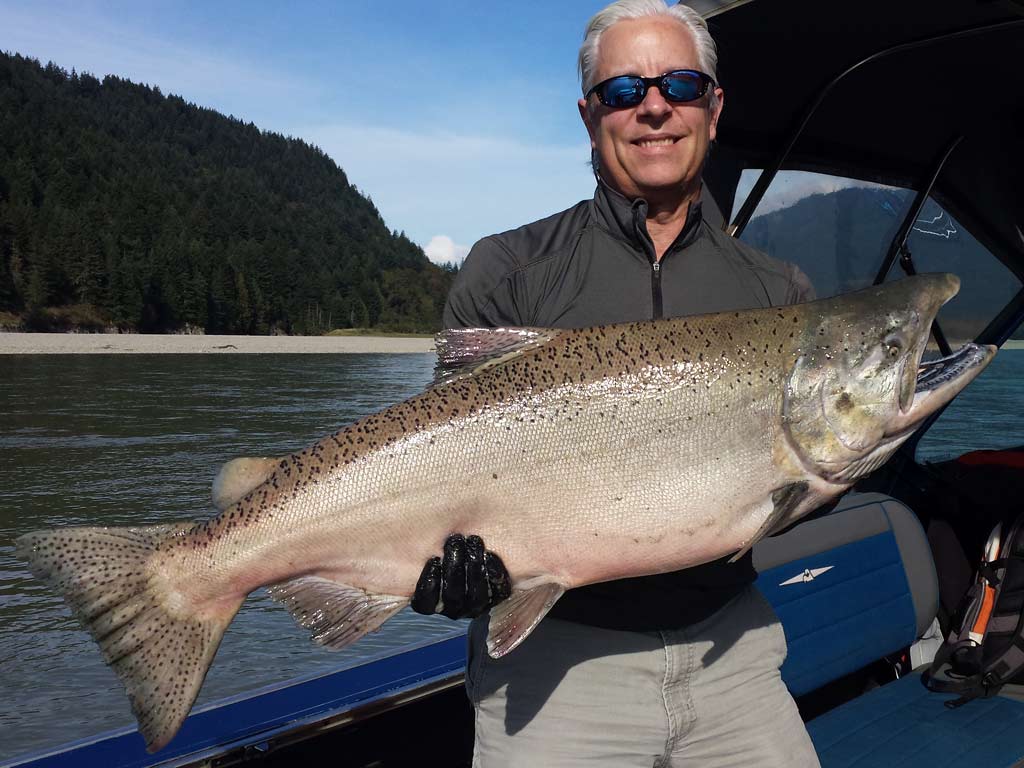
As for game quality, any angler will tell you Salmon are pound-for-pound some of the finest battlers you can encounter. There’s a longstanding debate as to which species of Salmon fights the best. What’s certain, though, is that there’s never a boring day on the water when these fish are biting.
So when can you catch Salmon on the Fraser River? The general answer is from June through December. But different species show up in the river at different times, with the Chinook bite starting in June. They’re followed by Sockeye and, on odd years, Pink Salmon. Then, Chum and Coho appear in the fall.
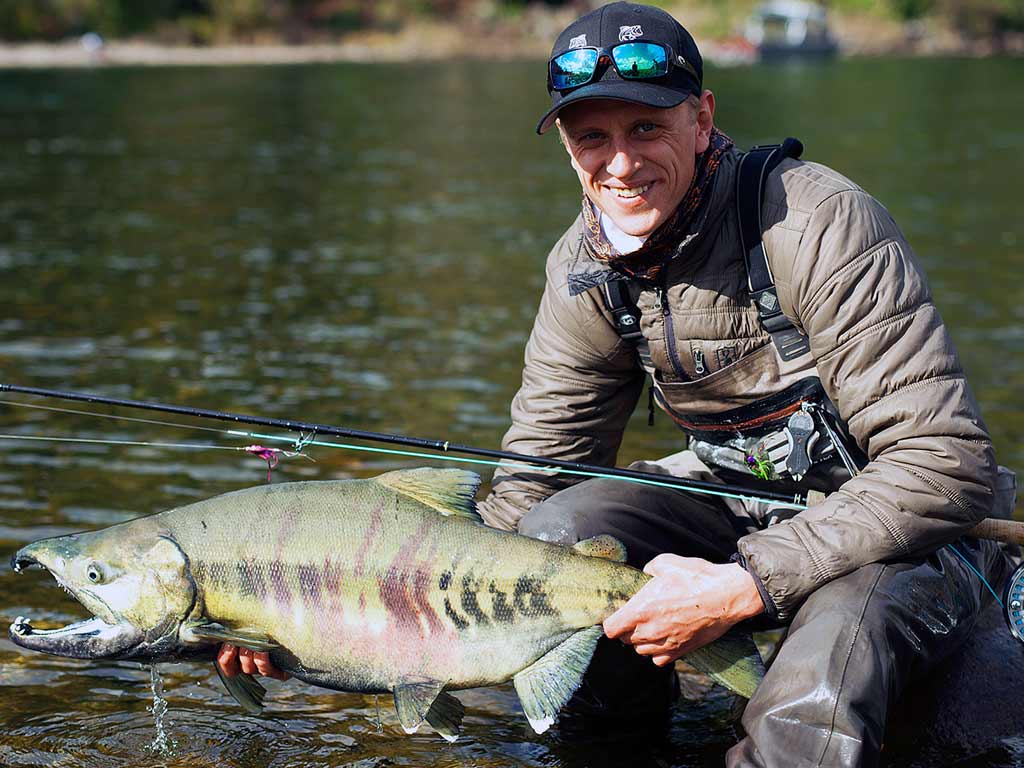
Of the five species, Sockeye Salmon are a bit of a special story. They’re notorious for rarely ever wanting to bite once they reach the Fraser River’s waters. Instead, anglers catch them by bottom bouncing, except for when the regulations advise otherwise. In many fisheries, bottom bouncing is considered a controversial technique. However, in the Fraser, it’s an accepted method of fishing for Sockeye.
Trout and Char
Another two species you’ll find racing along the Fraser River and its many side channels and tributaries are Trout and Char. They’re often overshadowed by Salmon and Sturgeon fishing from spring to late fall. However, once winter hits, it’s these fish that often take the center stage out here.
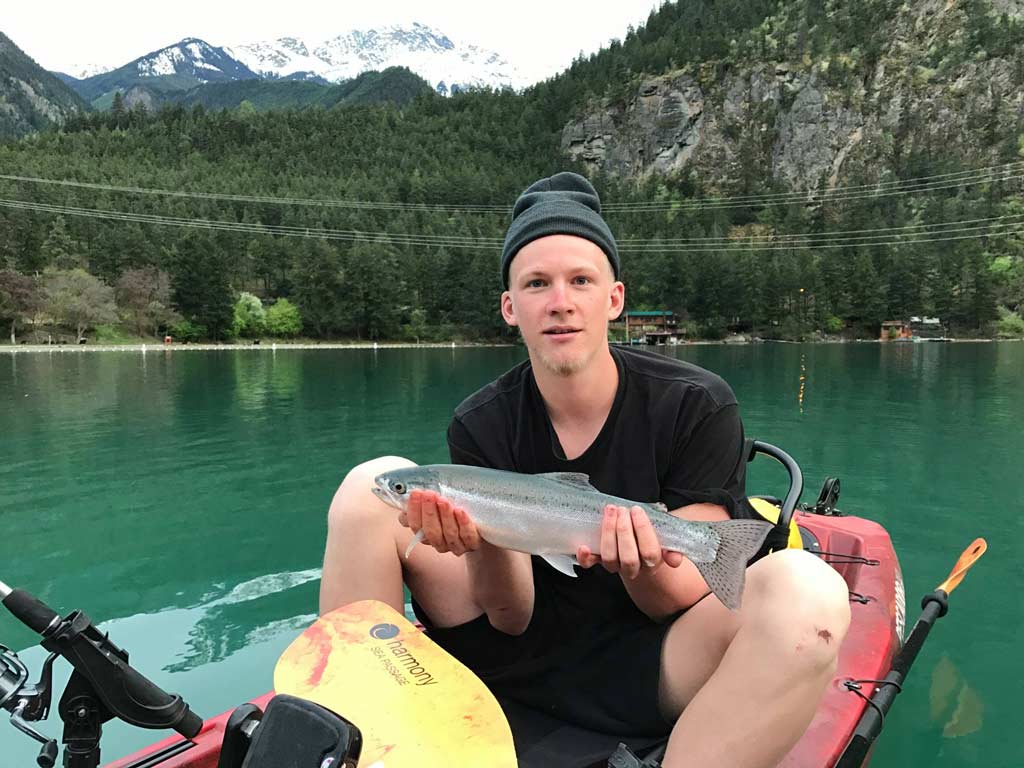
In particular, the Fraser River is home to Cutthroat Trout, Rainbow Trout, and their sea-run variety – Steelhead. There are also Bull Trout, which are actually a species of Char, despite what their common name would tell you. But either way, all of these fish are fun to catch, especially if you try do so on the fly.
As we mentioned, the prime time to catch Trout and Char is the wintertime, between December and April. During this time, the Fraser’s waters clear up, creating a true winter wonderland – as long as you bundle up appropriately! Besides the main river, there’s often great fishing in the smaller tributary waters, so don’t hesitate to go off the beaten path.
How can I fish on the Fraser River?
Depending on your preferences, what you want to catch, and where you want to go, there are different ways to tackle the Fraser River. While there’ll be fish to catch either way, your experience on the river will vary based on how you approach it. Check out a few ways to fish on the Fraser River.
Boat Fishing With a Guide
As with any fishery out there, exploring the Fraser River with someone who knows the waters is by far the most efficient way to have a productive trip. And local Fraser River fishing guides are truly worth their weight in gold.
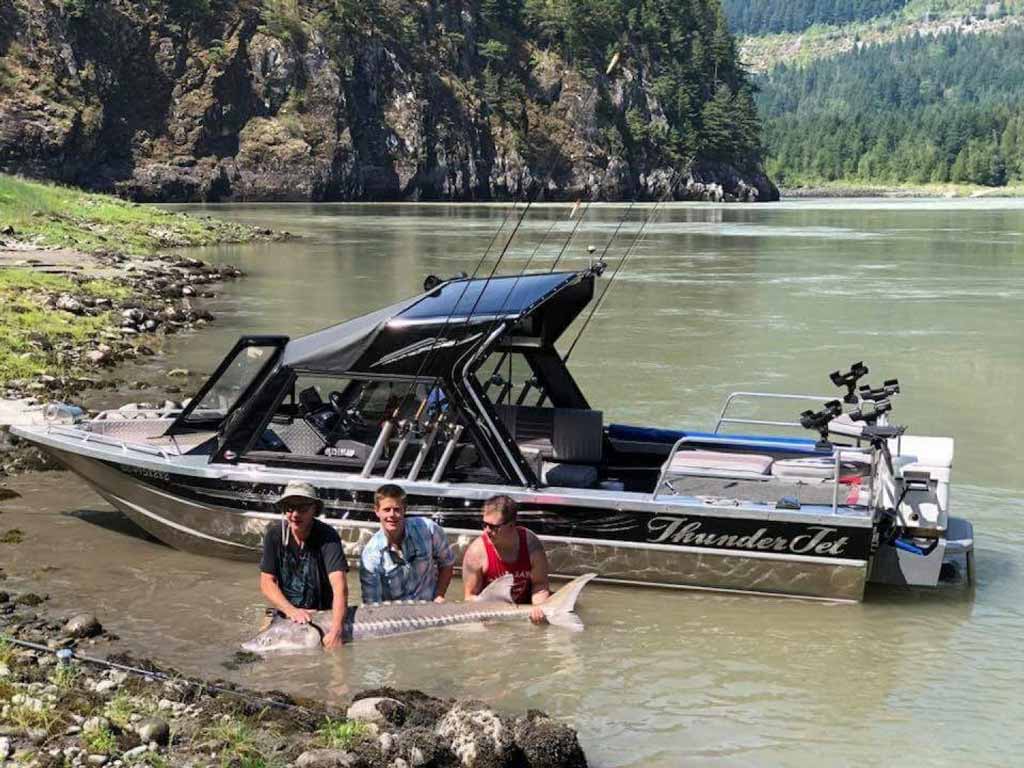
First of all, they’ll supply you with all the necessary equipment you need. Sure, you may already have your fly fishing gear or a Salmon rod ready to go. However, not many solo anglers out there have the tackle that can withstand a hulking White Sturgeon!
Secondly, there’s the vast knowledge of the Fraser River fishing grounds that you only really have access to if you’re fishing with a guide. They’ll know what’s biting at the time of your trip, where the fish may be, what they’ll be biting on, and when. All of these things play a crucial role in how successful your trip ends up being.
Finally, your guide will also provide you with a vessel to navigate the river. With it, you’ll be able to cover a lot more water, switching between different spots seamlessly. Put all this together, and it’s easy to see why most visiting anglers choose to pair up with a pro, especially when fishing the Fraser River for the first time.
Bar Fishing
While a boat and a guide will make your Fraser adventure more diverse and efficient, shore fishing is also a great way to catch some fish out here. It mostly takes place along the river’s various rocky beaches, referred to as bars. From these, you can reel in all the river’s species, including Sturgeon.

It’s really all about bringing the right gear and picking the right spots. If it’s your first time visiting these waters, make sure to check out the DFO website beforehand. There, you’ll find information on whether the portion of the Fraser River you intend to fish in is open, as well as what you can fish for.
You can also consider tackling some of the side channels. The Vedder River, also known as Chilliwack, is a popular tributary of the Fraser. During summer, it offers good Salmon fishing, while in winter, there’ll be feisty Steelhead to battle. All in all, whether you choose to fish the main river or some of its tributaries, shore fishing can be very productive all over British Columbia.
Kayak Fishing
A third way to fish the Fraser is to do it aboard a kayak. For those versed in kayak angling, it’s a fantastic way to tackle these waters. You can either do it solo by renting a kayak, or you can find a guide that offers kayak fishing tours.
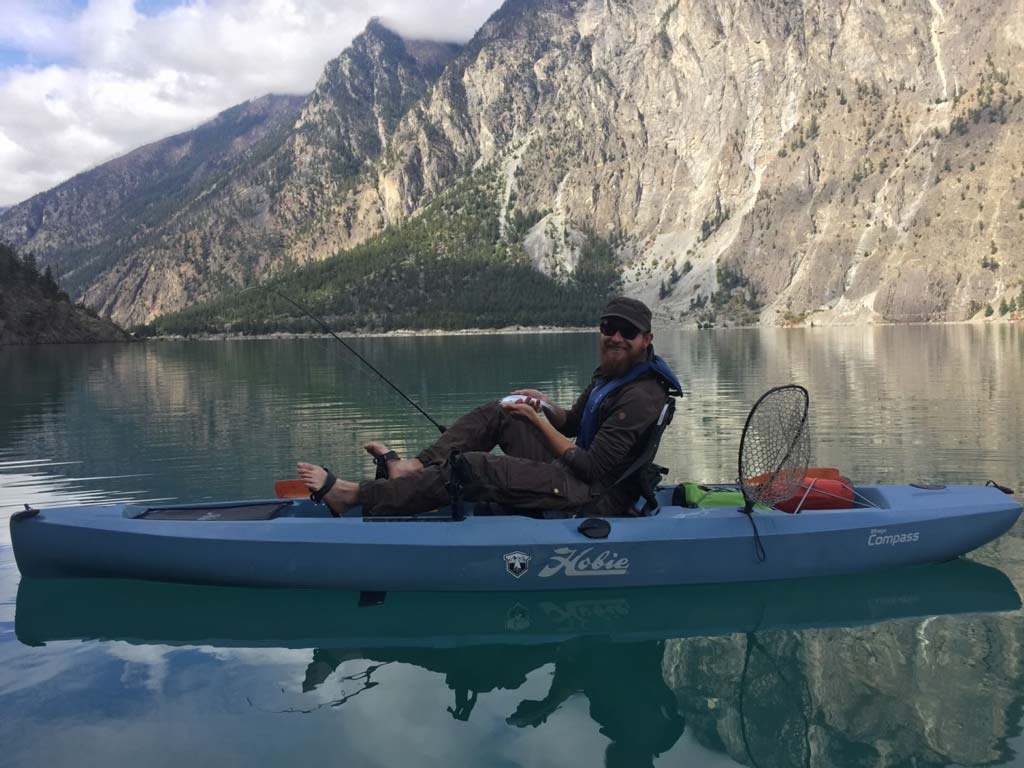
Kayaks will give you similar versatility to a boat, allowing you to approach your potential fishing spots in a stealthy manner, and switch between them with ease. On the Fraser River, kayak anglers catch have been known to catch all of the river’s species, including Sturgeon. Now, whether you feel like wrestling one aboard a kayak is a good idea is up to your experience and good judgment. But even if you decide not to take on the river monsters, there are still other fish to reel in.
Where can I fish the Fraser River?

We’ve covered the species you can catch and ways to fish the Fraser River. Now, it’s time to delve into some places worth exploring. Of course, if you’re fishing with a guide, they’ll let you know right away where the best bite is. Still, let’s take a look at a few areas you could visit on your trip.
- Lillooet: Nestled on the western banks of the Fraser River, in the heart of its canyon, Lilloeet is a small city with epic fishing potential. Here, nature resembles something from a fairytale, with stunning views and big, hearty fish. Sturgeon, Salmon, and Trout are all common catches in Lillooet.
- Hope: Sitting at the confluence of the Fraser River and its tributary, the Coquihalla River, Hope will give you access to various fishing grounds in the main river and around it. While most of the fishing here is done by boat, there are a few bars you can cast from, including the Pipeline Bar. Like elsewhere along the river, there’s a healthy population of Sturgeon lurking here, as well as Salmon and Steelhead.
- Chilliwack: Head about half an hour downriver from Hope, and you’ll reach Chilliwack. The city is surrounded by mountains and it’s famous for its outdoor activities. Many visit it to hike, camp, and, of course, fish. It lies at the confluence of the Fraser and Chilliwack Rivers, giving anglers access to both fisheries. Whether you’re looking to hunt for giant Sturgeon, reel in some Salmon, or fly fish for Trout, it’s all possible in Chilliwack.
- Mission: Mission is a small city located about an hour east of Vancouver. Its CPR Bridge represents the boundary between the tidal and non-tidal Fraser River. This is significant because the regulations and the licenses you’ll use differ between the two. But besides that, Mission also features prolific Salmon fishing opportunities. Sturgeon are also often caught, and you can even fish for them from shore on the nearby Stave River.
- Richmond: Finally, there’s Richmond, which sits at the very mouth of the Fraser River. The city has access to both the river’s North and South Arms. You’ll find different piers along both arms where you can cast into the river. On charter boats, you’ll even get the option to venture out of the river and into the Strait of Georgia.
Fraser River Fishing Rules and Regulations
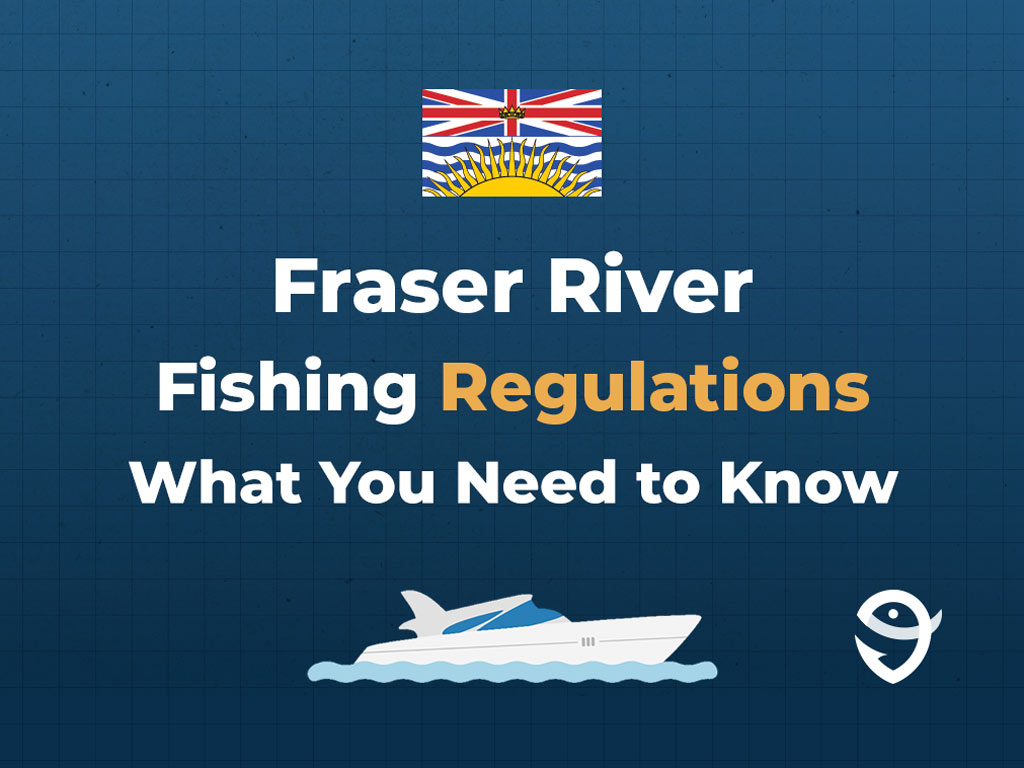
Before you’re ready to head out and experience all the magnificent angling and nature the Fraser River has to offer, it’s always a good idea to get familiar with the local fishing regulations. We’ve already mentioned the CPR Bridge in Mission as the boundary between the river’s tidal and non-tidal regions. This is an important distinction because you’ll need a saltwater license in the tidal Fraser, and a freshwater license upriver from the bridge.
Also, the fishing regulations themselves often vary between the tidal and the non-tidal parts of the Fraser. These are subject to change almost every year, so it’s best to get familiar with them as you start planning your adventure. You can get this information by visiting the DFO website.
Fraser River: Where Dinosaurs Still Roam

With beautiful nature and incredible fishing throughout its course, the Fraser River is rightfully a place anglers travel to from near and far. With ancient White Sturgeon lurking in its waters, as well as millions of Salmon racing through it each year, journeying out to these parts is well worth the effort. And whatever you decide to fish for in the end, you can be sure that the Fraser River will deliver and stay in your memories forever.
Have you ever been fishing on the Fraser River? What’s your favorite fish to target on it? Let us know in the comments down below.
The post Fishing on the Fraser River: The Complete Guide appeared first on FishingBooker Blog.
https://ift.tt/6qCUA8z
0 Comments
Enregistrer un commentaire